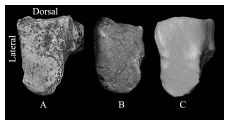Daniel J. Proctor
Source -http://www.sciencedirect.com/science/article/pii/S0047248413002030
Journal of Human Evolution, Volume 65, Issue 6 , December 2013, Pages 761–769
Abstract
This study quantifies the proximal articular surface shape of metatarsal (MT) 4 and MT 5 using three-dimensional morphometrics. Humans and apes are compared to test whether they have significantly different shapes that are skeletal correlates to comparative lateral foot function. In addition, shod and unshod humans are compared to test for significant differences in surface shape. The MT 4 fossils OH 8, Stw 628, and AL 333-160, and the MT 5 fossils AL 333-13, AL 333-78, OH 8, and Stw 114/115 are compared with humans and apes to assess whether they bear greater similarities to humans, which would imply a relatively stable lateral foot, or to apes, which would imply a flexible foot with a midfoot break. Apes have a convex curved MT 4 surface, and humans have a flat surface. The MT 4 fossils show greater similarity to unshod humans, suggesting a stable lateral foot. Unshod humans have a relatively flatter MT 4 surface compared with shod humans. There is much overlap in MT 5 shape between humans and apes, with more similarity between humans and Gorilla. The fossil MT 5 surfaces are generally flat, most similar to humans and Gorilla. Because of the high degree of shape overlap between humans and apes, one must use caution in interpreting lateral foot function from the proximal MT 5 surface alone.

Figure 1. MT 4 fossil images (not to scale): A) Stw 628, a right flipped to appear as a left; B) OH 8; C) AL 333-160.

Figure 4. Representative MT 5 proximal surface image of groups: A) Gorilla; B) Pan; C) Hylobates; D) Homo; E) unshod Homo.